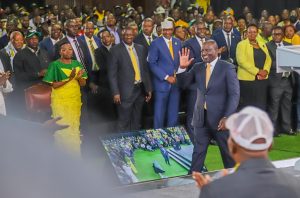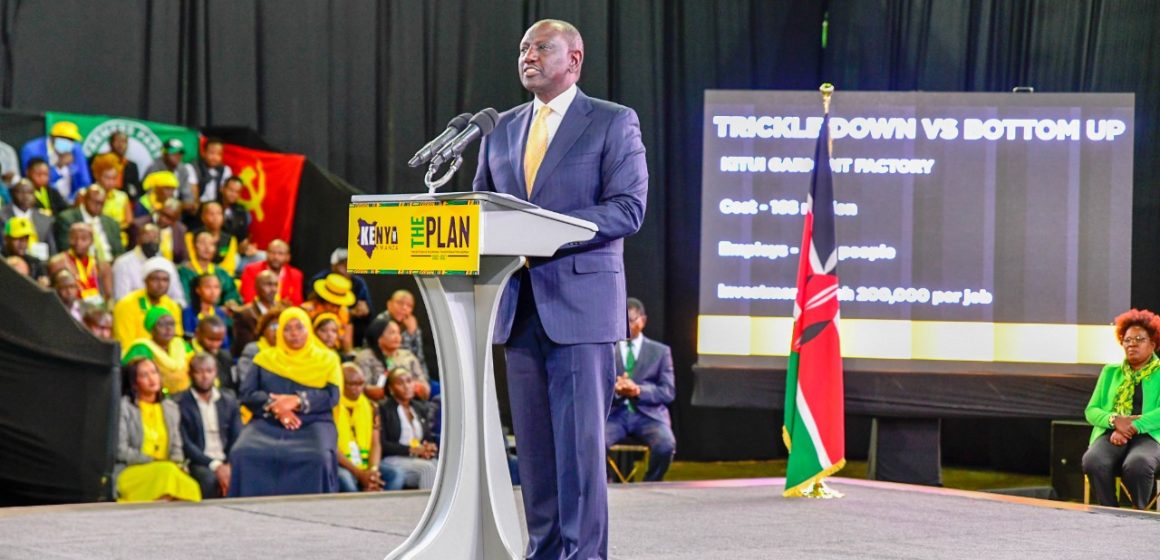|
LISTEN TO THIS THE AFRICANA VOICE ARTICLE NOW
Getting your Trinity Audio player ready...
|
On the last evening of June, a composed, sharp, and firm yet friendly William Ruto, Kenya’s Deputy President, took his time to read out and explain his manifesto to his fellow Kenyans as he once again sought to persuade them to vote for him as the fifth President in the fast-approaching August 9th polls.
Ruto’s manifesto carried heavy tinges of hope, which painted the United Democratic Alliance party leader as the savior Kenyans need. His campaign team has been announcing that “Freedom is coming” once Ruto takes over from Uhuru Kenyatta, his current boss– with whom he has bad blood.
Ruto’s supporters embraced the manifesto, and they once more bolster the hope of their preferred candidate winning the elections. Meanwhile, his critics downplayed the manifesto, terming it a plagiarised copy of President Kenyatta’s Big Four Agenda.
Azimio La Umoja running mate Martha Karua panned the manifesto saying she was shocked Ruto never addressed how his administration planned to tackle corruption.
“The fight against corruption is one of Azimio’s biggest priorities. When public resources are misused; we won’t have medical care, our children will not access quality education and our parents will miss social protection. Let us vote and join in Kenya’s biggest fight yet,” Karua said in a tweet.
Ruto, a smart orator, seemed to have mastered his document. He took quick glimpses at the copy and spent several minutes explaining the content thereof. He took pride in having engaged close to 258 scholars, technocrats, economists and people of diverse persuasions to develop the plan, or so he said.
“The fight against corruption is one of Azimio’s biggest priorities. When public resources are misused; we won’t have medical care, our children will not access quality education and our parents will miss social protection. Let us vote and join in Kenya’s biggest fight yet,” Karua said in a tweet.
He singled out seven key areas that his government will focus on, once he clinches victory on the ballot. They included agriculture, small-scale and medium-sized enterprises, housing and settlement, manufacturing, digital super highway, service economy and environment and climate change.
These areas, he said, have the ability to bring down the cost of living, eradicate hunger, create employment, and expand Kenya’s tax revenue base.
Once again, he lamented the current harsh economic times, which have sparked several protests in the country as a result of pushing many people to rock bottom vis-a-vis daily survival.
“Every Kenyan knows that the price of a 2kg packet of unga is now KSh. 230, up from KSh. 75 in 2018,” he said, probably alluding to the effect of the Handshake between Uhuru Kenyatta and Raila Odinga, who united in March of 2018.
The Kenya Kwanza presidential candidate bemoaned that the country spends KSh. 360 billion to import food and food items yet the majority of Kenyans who suffer hunger are farmers. This, he promised to overturn, and turn around the fortunes of agriculture.
“In 5 years, these two million farmers will create KSh. 500 billion worth of product,” Ruto said.
“Today, on average, every Kenyan spends 54 percent of their income on food. Kenya spends KSh 3 trillion on food, we’d save at least KSh. 300B if we invested in agriculture,” he added.
The former MP and minister of agriculture said that the Kenya Kwanza administration will complete the implementation of the 2010 constitution.
“Rather than mutilate the constitution for political expediency, there is a lot that still needs to be done to implement the 2010 constitution,” he said.
Ruto was found in a very awkward position when he had to subtly oppose the Building Bridges Initiative, which was an initiative of his boss Uhuru Kenyatta and former premier, Raila Odinga. Ruto opposed the initiative, and blamed the two for using BBI to change the constitution for their own gain, and at the expense of the common man.
“Rather than mutilate the constitution for political expediency, there is a lot that still needs to be done to implement the 2010 constitution,” Ruto said.
He further said that Kenya Kwanza, the coalition that brings together Amani National Congress headed by Musalia Mudavadi, UDA, and Ford Kenya led by Moses Wetangula, among others, will end the weaponization of state machinery, including anti-graft agency and criminal justice system. His government will enable the agencies to work independently, he said.
The Deputy President downplayed Azimio la Umoja’s Ksh 6,000 a month cash transfer to the unemployed people saying it was progressive and unsustainable.
“Our competitor’s handout program, in five years, will cost Ksh. 720 billion with zero return. Our plan will cost Ksh. 90 billion with Ksh. 500 billion return,” Ruto said. Instead of the cash transfers, Ruto said he would create jobs that will give jobs to the jobless.
Azimio la Umoja has proposed a Kshs 6000 monthly stipend to the poorest Kenyan estimated to be around 2 million families. The move aims at reducing child poverty and stimulate the economy. Such programs are common in the western world, where they’re known as welfare programs. In the US, the welfare program ensures no family is left without basic needs such as food, clothing and a place to live.
The Kenya Kwanza manifesto outlined plans to invest more in preventive healthcare, more preventative, and less in curative healthcare. Ruto said that NHIF, as it is today, has many exclusions that bar people who have cancer. He promised to do away with such exclusions.
“Within our first three months, we will procure and put in place a state-of-the-art integrated health information management system that will make it possible for health records of every Kenyan to be portable,” Ruto added.
On transport, the manifesto explained how it would end the perennial losses seen at Kenya Airways, the national carrier. The DP said the problem with the airline is internal managerial failure
“We can’t keep it on life support forever. We will turn Kenya Airways around in two years,” he said.
Ruto promised to connect Kenyans to the Internet to scale up digital growth and economy. To achieve this, he said every home, shopping center, school, and health facility connected to the grid would be connected to the Internet.
“Our competitor’s handout program, in five years, will cost Ksh. 720 billion with zero return. Our plan will cost Ksh. 90 billion with Ksh. 500 billion return,” Ruto said.
Ruto told off those criticizing his bottom-up economic model and its success. He said: “it’s not necessarily how much money we have but the policy choices we make; where we invest. That is the difference between the trickle-down economic model and bottom-up economic model.”

The manifesto further promised to offer half of the Cabinet to women to promote gender inclusivity and appoint all the judges nominated by the Judicial Service Commission to the Court of Appeal within 7 days of assuming office.
In June last year, President Kenyatta appointed only 34 of the 40 candidates nominated by the Judicial Service Commission to the Court of Appeal, Environment and Lands Court, and the Employment and Labour Relations Court.
Kenyatta said the nominees left out of the appointments had not met the threshold and would be referred back to JSC. Their fate is still pending.
Kenyans and leaders from various political divides have reacted to the Kenya Kwanza manifesto, raising the political temperatures higher and higher.
Millicent Omanga, UDA-allied nominated senator, said Ruto’s was the best manifesto since independence.
Walter Ambenge poked the document and termed DP Ruto a liar. “He was once an agricultural minister, and instead of helping his people who are farmers, the dude went ahead to import maize and sold it at kshs 3800 per bag, and yet he proposed his people to sell maize to NCBP at ksh 800 per bag.”
“Just as I predicted earlier in the day, William Ruto’s loud silence on the fight against corruption during his manifesto launch is spectacular,” MP Opiyo Wandayi weeted.
Danice Okumu said: “Some things are very easy to say but implementing is a problem. In 2013 DP promised many things they’ll do in 3 months.”
Rachel Ruto, William Ruto’s wife, termed the manifesto “inspiring” and “well researched.”
“It serves as a guide for how we will overcome the economic catastrophe we are currently experiencing and forge a new social fabric,” Ms. Ruto wrote on Twitter.
Stephen Mutoro, a political commentator, said Kenyans should stop blaming Ruto for Uhuru’s failures.
“Some disgruntled people blaming DP Ruto for the poor performance of Uhuru Kenyatta have no idea that the neck can never be above the head. Article 147(2) gives the President discretion to delegate functions to the DP,” he said.
David Makali, another political analyst, said: “Great proposals for Kenya’s development coming from the Kenya Kwanza manifesto. Transformative if implemented, resources and politics aside. But shall they? And those back-breaking timelines!”
Opiyo Wandayi, the MP for Ugunja, faulted the manifesto for its lack of ways to fight corruption.
“Just as I predicted earlier in the day, William Ruto’s loud silence on the fight against corruption during his manifesto launch is spectacular,” he tweeted.
Senior Counsel Ahmednassir Abdullahi, an ardent supporter of Ruto, said the manifesto is glowing, breathtaking, and amazing.
“Epoch defining! What a call to arms! What a plea for unity! What a shout for change! What a vision for a better tomorrow! What a beacon for a bright tomorrow! Congratulations! DP Ruto and his entire team,” Abdullahi said on his Twitter account.






























LEAVE A COMMENT
You must be logged in to post a comment.